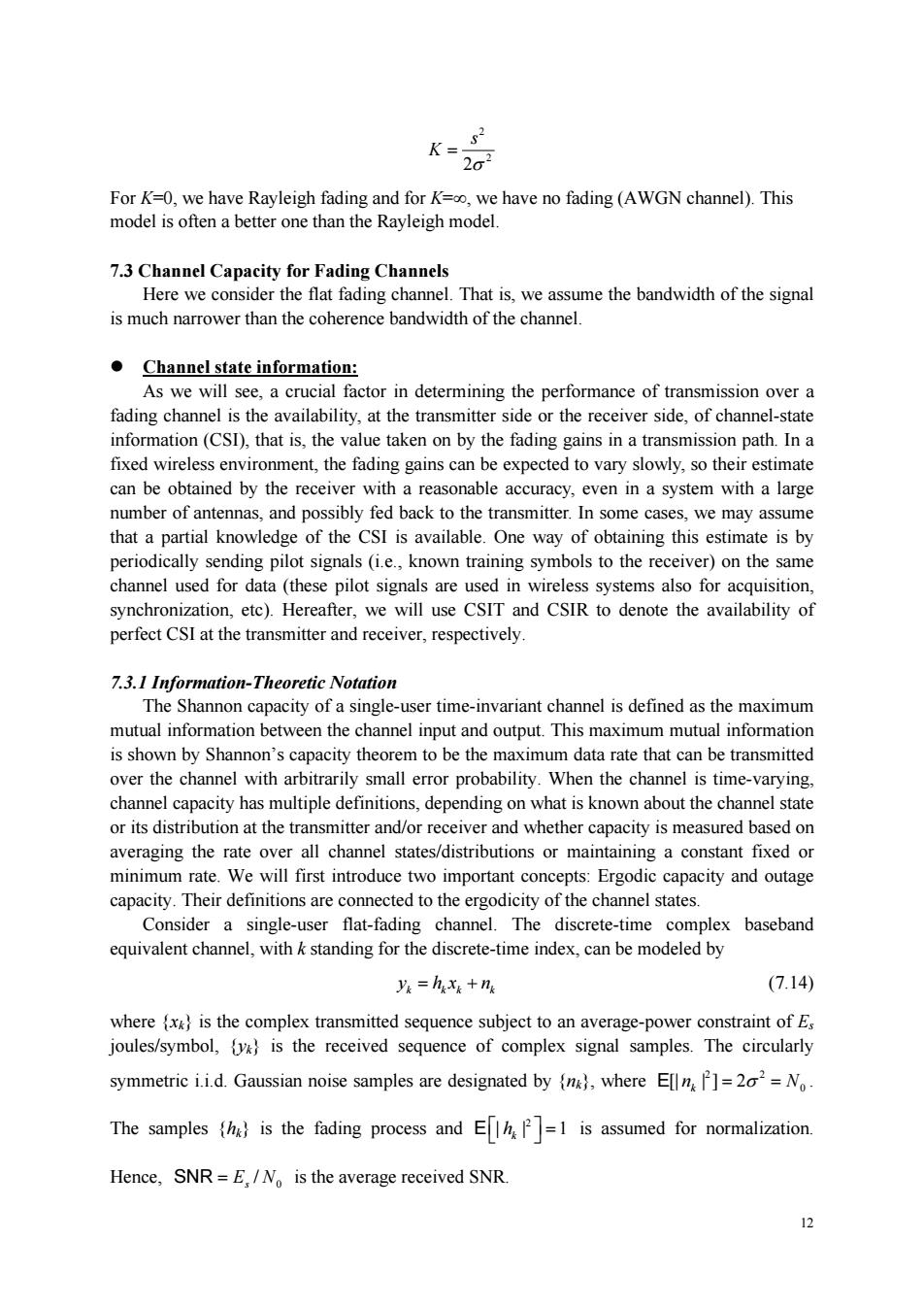正在加载图片...

For K=0,we have Rayleigh fading and for K=o,we have no fading(AWGN channel).This model is often a better one than the Rayleigh model. 7.3 Channel Capacity for Fading Channels Here we consi er the flat fading channe .That is,we assume the bandwidth of the signal is much narrower than the coherence bandwidth of the channel Channel state information: As we will see,a crucial factor in determining the performance of transmission over a fading channel is the availability,at the transmitte e or the receiver side,of channel-s information(CSD).that is,the value taken on by the fading gains in a transmission path.In a fixed wireless environment,the fading gains can be expected to vary slowly,so their estimate can be obtained by the receiver with a reasonable accuracy,even in a system with a large number of antennas,and possibly fed back to the transmitter.In some cases,we may assume that a partial k f the CSI is available.One wa of obtaining this estim is by periodically sending pilot signals (i.e.,known training symbols to the receiver)on the same channel used for data (these pilot signals are used in wireless systems also for acquisition, synchronization,etc).Hereafter,we will use CSIT and CSIR to denote the availability of perfect CSIat the transmitter and receiver,respectively. retic Notati y ofertiminvn hnte mutual information between the channel input and output.This maximum mutual information is shown by Shannon's capacity theorem to be the maximum data rate that can be transmitted over the channel with arbitrarily small error probability.When the channel is time-varying, chanr city has multipledefinitions dep nding on what is kn own about the char ne l state or its distribution at the transmitter and/or receiver and whether capacity is measured based on averaging the rate over all channel states/distributions or maintaining a constant fixed or minimum rate.We will first introduce two important concepts:Ergodic capacity and outage capacity.Their definitions are connected to the ergodicity of the channel states. Consider a single-user flat-fading channel.The discrete-time complex baseband equivalent channel,withk standing for the discrete-time index,can be modeled by y:=hx+ng (7.14) wherex is the complex transmitted sequence subject to an average-power constraint of E joules/symbol,is the received sequence of complex signal samples.The circularly symmetric i.i.d.Gaussian noise samples are designated by where El]=N The samples is the fading process and E=1 is assumed for normalization. Hence,SNR=E,/N is the average received SNR.12 2 2 2 s K For K=0, we have Rayleigh fading and for K=, we have no fading (AWGN channel). This model is often a better one than the Rayleigh model. 7.3 Channel Capacity for Fading Channels Here we consider the flat fading channel. That is, we assume the bandwidth of the signal is much narrower than the coherence bandwidth of the channel. Channel state information: As we will see, a crucial factor in determining the performance of transmission over a fading channel is the availability, at the transmitter side or the receiver side, of channel-state information (CSI), that is, the value taken on by the fading gains in a transmission path. In a fixed wireless environment, the fading gains can be expected to vary slowly, so their estimate can be obtained by the receiver with a reasonable accuracy, even in a system with a large number of antennas, and possibly fed back to the transmitter. In some cases, we may assume that a partial knowledge of the CSI is available. One way of obtaining this estimate is by periodically sending pilot signals (i.e., known training symbols to the receiver) on the same channel used for data (these pilot signals are used in wireless systems also for acquisition, synchronization, etc). Hereafter, we will use CSIT and CSIR to denote the availability of perfect CSI at the transmitter and receiver, respectively. 7.3.1 Information-Theoretic Notation The Shannon capacity of a single-user time-invariant channel is defined as the maximum mutual information between the channel input and output. This maximum mutual information is shown by Shannon’s capacity theorem to be the maximum data rate that can be transmitted over the channel with arbitrarily small error probability. When the channel is time-varying, channel capacity has multiple definitions, depending on what is known about the channel state or its distribution at the transmitter and/or receiver and whether capacity is measured based on averaging the rate over all channel states/distributions or maintaining a constant fixed or minimum rate. We will first introduce two important concepts: Ergodic capacity and outage capacity. Their definitions are connected to the ergodicity of the channel states. Consider a single-user flat-fading channel. The discrete-time complex baseband equivalent channel, with k standing for the discrete-time index, can be modeled by k kk k y hx n (7.14) where {xk} is the complex transmitted sequence subject to an average-power constraint of Es joules/symbol, {yk} is the received sequence of complex signal samples. The circularly symmetric i.i.d. Gaussian noise samples are designated by {nk}, where 2 2 0 [| | ] 2 k E n N . The samples {hk} is the fading process and 2 || 1 k h E is assumed for normalization. Hence, 0 / SNR E N s is the average received SNR